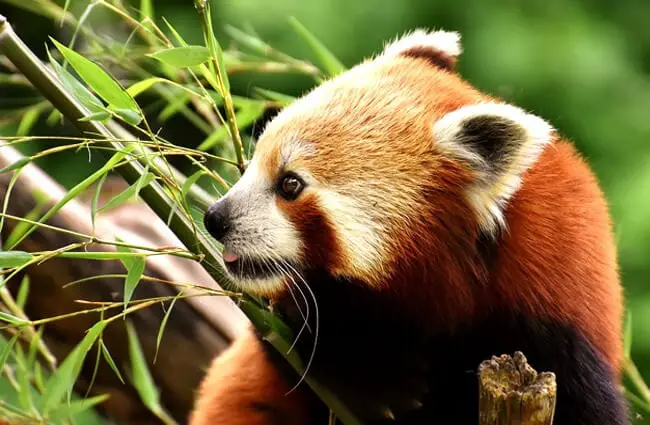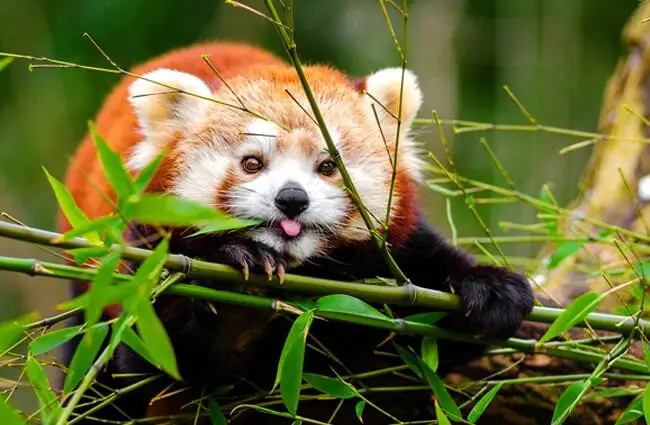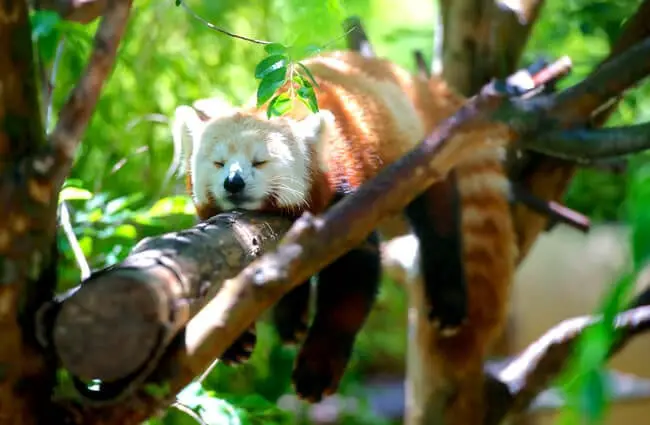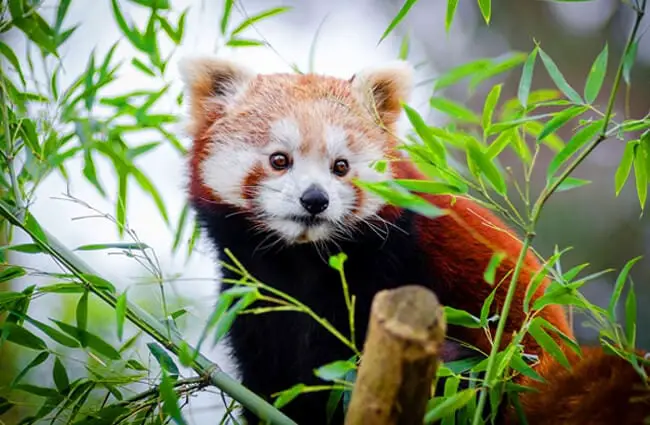In the misty, high-altitude forests of the Himalayas, a creature of striking beauty and elusive charm makes its home. Often mistaken for a distant relative of the Giant Panda or even a raccoon, the Red Panda, with its fiery fur and bushy ringed tail, stands as a unique marvel of evolution. This captivating mammal, a true arboreal acrobat, holds a special place in the hearts of animal enthusiasts and scientists alike. Join us on a journey to uncover the secrets of this remarkable species, from its ancient lineage to its vital role in the ecosystem, and learn how we can all contribute to its survival.
The Enigmatic Ember of the Himalayas: Unveiling the Red Panda
A Glimpse into Their World: Basic Facts and Identification
The Red Panda (Ailurus fulgens), also affectionately known as the “lesser panda,” “firefox,” or “cat-bear,” is a creature of exquisite design. Roughly the size of a domestic cat, though with a much longer, bushy tail, it typically measures about 40 to 60 centimeters (16 to 24 inches) in body length, with its tail adding another 30 to 48 centimeters (12 to 19 inches). Weighing between 3 to 6 kilograms (6 to 13 pounds), its compact build belies its agility. Its most striking feature is its dense, reddish-brown fur, which provides excellent camouflage against moss and reddish-brown tree bark. The face is marked with distinct white tear-like streaks extending from the eyes to the corners of the mouth, contrasting sharply with the darker reddish-brown mask. Its ears are prominent and pointed, tipped with white, and its underparts are dark, almost black. The tail, a marvel of balance and warmth, is adorned with alternating reddish and lighter rings.
Where the Wild Things Are: Habitat and Distribution
The natural realm of the Red Panda spans a narrow band across the temperate forests of the eastern Himalayas and southwestern China. Its range includes Nepal, Bhutan, northern India (Sikkim, Arunachal Pradesh), Myanmar, and the provinces of Sichuan and Yunnan in China. These animals thrive in high-altitude environments, typically found between 2,200 and 4,800 meters (7,200 to 15,700 feet) above sea level. Their preferred habitat is characterized by temperate broadleaf and coniferous forests, particularly those with a dense understory of bamboo and abundant tree cover. The presence of old-growth trees with hollows and snags is crucial, as these provide essential denning sites and safe havens. The climate in these regions is often cool and humid, with significant rainfall and frequent mist, conditions to which the Red Panda is perfectly adapted.

A Life in the Trees: Behavior and Ecology
The Bamboo Connoisseur: Diet and Feeding Habits
Despite its classification in the order Carnivora, the Red Panda is primarily an herbivore, with bamboo forming the cornerstone of its diet. Specifically, it favors the tender shoots and leaves of various bamboo species. This dietary specialization is a fascinating example of convergent evolution with the Giant Panda, though they are not closely related. Beyond bamboo, their diet is surprisingly diverse and seasonal, adapting to what is available in their forest home. They will supplement their meals with fruits, acorns, roots, and occasionally insects, bird eggs, or small rodents. This omnivorous flexibility allows them to survive periods when bamboo is less abundant. Like the Giant Panda, Red Pandas possess an enlarged wrist bone that functions as a “false thumb,” aiding them in grasping bamboo stalks and other food items. Their digestive system, however, is still largely carnivorous, meaning they extract relatively little nutrition from bamboo, necessitating that they consume large quantities to meet their energy needs. They obtain much of their water intake directly from their food, especially the succulent bamboo shoots, and from dew or rain on leaves.

Daily Rhythms: Activity Patterns and Social Life
Red Pandas are predominantly crepuscular and nocturnal, meaning they are most active during the twilight hours of dawn and dusk, and sometimes throughout the night. During the day, they typically rest in trees, often curled up on branches with their tails wrapped around them for warmth and camouflage, or nestled within tree hollows. They are largely solitary animals, preferring to live alone except during the breeding season. Communication among individuals is primarily through scent marking, using glands on their anal region and footpads, as well as urine. They also employ a range of vocalizations, including squeals, whistles, and huff-quacks, to express alarm or communicate with potential mates. Grooming is an essential part of their daily routine, keeping their dense fur clean and insulating. They use their forepaws to clean their faces and then rub their bodies against trees or rocks.
Masters of the Canopy: Movement and Adaptations
The Red Panda is an exceptionally agile and adept arboreal creature. Its semi-retractable claws provide an excellent grip for climbing trees, and its strong, muscular legs allow it to navigate the forest canopy with ease. The long, bushy tail serves as a crucial counterbalance, enabling them to maintain stability while moving along narrow branches or descending headfirst down tree trunks. Their flexible ankles can rotate nearly 180 degrees, a remarkable adaptation for climbing down trees with their heads facing the ground. When threatened, they often climb to the highest branches or seek refuge in tree hollows. On the ground, they move with a somewhat waddling gait, but their true grace is revealed high above.

The Circle of Life: Reproduction and Development
Courtship and Family Life: Mating and Parental Care
The breeding season for Red Pandas typically occurs from January to March. During this time, the usually solitary individuals seek out mates, often communicating through scent marks and vocalizations. After a gestation period of approximately 90 to 150 days, which can vary due to a phenomenon called delayed implantation (where the fertilized egg does not immediately implant in the uterine wall), the female gives birth to a litter of one to four cubs, most commonly two. Births usually take place between May and July. The mother prepares a den in a hollow tree, a rock crevice, or a dense thicket of bamboo. Newborn cubs are tiny, blind, and helpless, weighing only about 100 to 150 grams (3.5 to 5.3 ounces). They are covered in a thick, grayish fur. The mother is the primary caregiver, nursing the cubs and keeping them warm. The cubs open their eyes after about 18 days and begin to venture out of the den around three months of age. They are weaned at about six to eight months but remain with their mother until they are around one year old, learning essential survival skills such as foraging and climbing. Sexual maturity is reached at about 18 to 20 months.
An Ancient Lineage: Evolutionary Journey
A Taxonomic Puzzle: Unraveling Red Panda Phylogeny
The evolutionary history of the Red Panda is a fascinating tale of scientific discovery and reclassification. For a long time, its taxonomic placement was a subject of debate. Early classifications linked it with raccoons (family Procyonidae) due to morphological similarities, while others suggested a closer relationship with bears (family Ursidae), particularly the Giant Panda, due to shared dietary habits. However, modern genetic studies have firmly established the Red Panda in its own unique family, Ailuridae, making it the sole living member of this ancient lineage. This means the Red Panda is neither a bear nor a raccoon, but rather a distinct evolutionary branch. Its resemblance to the Giant Panda in terms of diet and the “false thumb” is a classic example of convergent evolution, where unrelated species develop similar traits due to adapting to similar ecological niches.
Adaptations Through Time: Surviving in a Niche
The Red Panda’s unique evolutionary path has equipped it with a suite of specialized adaptations for its high-altitude, bamboo-rich environment. Its thick fur provides excellent insulation against the cold and damp conditions. The dense fur on its soles offers additional insulation and grip on slippery, moss-covered branches. Its powerful jaws and teeth are adapted for grinding tough plant material, particularly bamboo. The aforementioned “false thumb” is a key anatomical innovation for its bamboo-heavy diet. Physiologically, Red Pandas have a relatively slow metabolic rate, which helps them conserve energy in their cool habitat and from their low-nutrient diet. These adaptations highlight millions of years of fine-tuning to its specific ecological niche.
Weaving Through the Web of Life: Ecosystem Role and Interactions
More Than Just a Pretty Face: Ecological Contributions
While often celebrated for its charismatic appearance, the Red Panda plays a subtle yet significant role in its forest ecosystem. As a primary consumer of bamboo, it helps regulate the growth of this dominant plant, preventing it from overrunning other vegetation. Furthermore, by consuming fruits and berries, Red Pandas contribute to seed dispersal, aiding in the regeneration and diversity of forest flora. Their presence also serves as an indicator of forest health. A thriving Red Panda population suggests a healthy, intact forest ecosystem, making them an important indicator species for conservation efforts in the eastern Himalayas.
Neighbors in the Wild: Interactions with Other Species
In their natural habitat, Red Pandas share their territory with a variety of other species. Their primary predators include snow leopards, clouded leopards, and martens, particularly for young or vulnerable individuals. They generally avoid direct competition with other herbivores by specializing in bamboo and utilizing different parts of the forest canopy. They coexist with other arboreal mammals, such as various monkey species and civets, by occupying different niches or being active at different times. Their solitary and arboreal nature generally minimizes direct conflict with most other animals, allowing them to maintain their quiet existence in the forest.
Red Pandas and Humanity: Culture, Conservation, and Coexistence
A Cultural Icon: Red Pandas in Human Lore and Media
The Red Panda’s endearing appearance has earned it a special place in human culture. In some local folklore within its range, it is seen as a symbol of peace and good fortune. Globally, its unique charm has made it a popular figure in popular media, including animated films, video games, and various merchandise, significantly raising its profile and fostering affection worldwide. Its image is often used to represent cuteness and gentle wildness, making it an excellent ambassador for wildlife conservation.
Facing the Future: Threats and Conservation Efforts
Despite their charm, Red Pandas face severe threats, leading to their classification as an Endangered species by the IUCN. The primary threat is habitat loss and fragmentation, driven by deforestation for agriculture, logging, human settlements, and infrastructure development. Poaching for their distinctive fur and for the illegal pet trade also poses a significant danger. Climate change further exacerbates these issues, altering their delicate habitat. Conservation efforts are multifaceted and crucial for their survival. These include establishing and expanding protected areas and national parks, implementing anti-poaching measures, and promoting sustainable forest management practices. Community engagement is vital, involving local populations in conservation through education and providing alternative livelihoods to reduce reliance on forest resources. International breeding programs in zoos also play a critical role in maintaining a healthy captive population and raising public awareness.

Encountering a Wild Red Panda: A Guide for Responsible Observation
For the dedicated animal lover or aspiring zoologist hoping to catch a glimpse of a Red Panda in its natural habitat, patience and respect are paramount. They are incredibly shy and elusive. To increase your chances, focus on areas known for Red Panda populations in Nepal, Bhutan, or India, and consider hiring experienced local guides who understand their behavior and habitat. Look for signs such as droppings or claw marks on trees. The best times for observation are dawn and dusk. If you are fortunate enough to encounter a wild Red Panda:
- Maintain a respectful distance: Never approach or attempt to touch the animal. Use binoculars or a telephoto lens for viewing.
- Remain quiet and still: Sudden movements or loud noises can stress the animal and cause it to flee.
- Never feed wild animals: Feeding can alter their natural behavior, make them dependent on humans, and expose them to diseases.
- Observe, do not interfere: Allow the Red Panda to continue its natural activities undisturbed.
- Support local conservation: Choose eco-tourism operators who prioritize ethical wildlife viewing and contribute to conservation efforts.
Remember, your presence in their habitat should be as unobtrusive as possible, ensuring both your safety and the well-being of this magnificent creature.
Guardians of the Species: Red Panda Care in Captivity
For zookeepers, caring for Red Pandas in captivity is a specialized and rewarding task, crucial for conservation breeding programs and public education. Key responsibilities and considerations include:
- Dietary Management:
- Provide a primary diet of fresh bamboo, supplemented with specialized omnivore biscuits, fruits (apples, grapes, berries), and vegetables (sweet potato, carrots).
- Monitor intake carefully, as their digestive system is inefficient.
- Ensure constant access to fresh water.
- Enclosure Design and Maintenance:
- Replicate their natural arboreal habitat with plenty of climbing structures, branches, and elevated platforms.
- Include sheltered areas, such as tree hollows or nest boxes, for resting and denning.
- Maintain a cool, humid environment, often requiring misters or climate control in warmer regions.
- Regularly clean enclosures to prevent disease.
- Enrichment:
- Offer a variety of enrichment items to stimulate natural behaviors, such as puzzle feeders, scent trails, new climbing structures, and different types of browse.
- Rotate enrichment items frequently to prevent habituation.
- Health Monitoring:
- Conduct regular veterinary checks, including weight monitoring, dental exams, and fecal analysis.
- Be vigilant for signs of stress or illness, such as changes in appetite, lethargy, or unusual behaviors.
- Administer vaccinations and parasite control as needed.
- Breeding Programs:
- Participate in Species Survival Plans (SSPs) to manage genetically diverse captive populations.
- Monitor breeding pairs for compatibility and signs of estrus.
- Provide quiet, secure denning sites for pregnant females.
- What to Avoid:
- Stressors: Loud noises, sudden movements, or excessive human presence can cause significant stress.
- Inappropriate Diet: Avoid sugary foods, processed human foods, or an insufficient quantity of bamboo.
- Lack of Enrichment: A barren enclosure leads to boredom and potential stereotypic behaviors.
- Improper Handling: Minimize direct handling and always prioritize positive reinforcement and training for cooperative care.
Fascinating Facts: A Red Panda Compendium
Here is a collection of intriguing facts that highlight the Red Panda’s unique characteristics:
- The scientific name Ailurus fulgens means “fire-colored cat.”
- They are the only living species in their family, Ailuridae, making them a “living fossil” in a sense.
- Red Pandas have a special gland at the base of their tail that secretes a musky scent for marking territory.
- Their thick, woolly fur covers even the soles of their feet, providing insulation and better grip on icy branches.
- They can descend trees headfirst, a feat few other mammals can accomplish, thanks to their flexible ankle joints.
- When startled or threatened, a Red Panda may stand on its hind legs to appear larger and use its sharp claws to defend itself.
- Despite their solitary nature, they communicate through a variety of sounds, including whistles, squeals, and a unique “huff-quack.”
- They spend a significant portion of their lives in trees, often sleeping curled up with their bushy tail covering their face for warmth.
- Red Pandas have a relatively long lifespan, living up to 8-10 years in the wild and up to 15 years in captivity.
- Their diet of bamboo is low in nutrients, requiring them to spend up to 13 hours a day foraging and eating.
- The popular web browser “Firefox” was named after the Red Panda.
The Red Panda is more than just an adorable face; it is a testament to the intricate beauty and resilience of nature. Its unique evolutionary path, specialized adaptations, and vital role in its ecosystem make it a species worthy of our deepest respect and most dedicated conservation efforts. By understanding their world, appreciating their challenges, and supporting initiatives that protect their habitats, we can ensure that these fiery embers of the Himalayas continue to grace our planet for generations to come. Their future, like the health of the forests they call home, ultimately rests in our hands.

![Red Angus Closeup of a beautiful Red Angus cowPhoto by: U.S. Department of Agriculture [pubic domain]https://creativecommons.org/licenses/by/2.0/](https://animals.net/wp-content/uploads/2020/03/Red-Angus-4-238x178.jpg)




![Red Angus Closeup of a beautiful Red Angus cowPhoto by: U.S. Department of Agriculture [pubic domain]https://creativecommons.org/licenses/by/2.0/](https://animals.net/wp-content/uploads/2020/03/Red-Angus-4-100x75.jpg)

